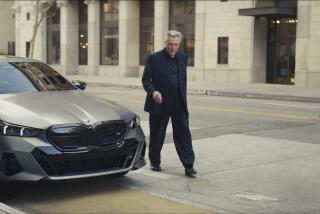Ad Strategies Seeking to Raise the Dead
- Share via
NEW YORK — Marketers, eager to latch onto a fresh approach that has proven it can work, have appropriated the dead as pitchmen. But their use of dead men walking -- and interacting with current events -- has made the technique look tired.
“This is hot now, but I believe the dead should stay dead,” said Bob Kuperman, chief executive of Omnicom Group’s TBWA/Chiat Day North America. “It’s borrowed interest and a short-lived phase.”
Recent examples include Fred Astaire dancing with a Dirt Devil vacuum cleaner and Coors Brewing Co. enlisting John Wayne along with Lorne Greene, Pernell Roberts, Dan Blocker and Michael Landon of the “Bonanza” television show to sell beer. General Foods-Kraft’s Good Humor-Breyers dusted off Shakespeare and the Mona Lisa to pitch Klondike ice cream bars.
The dead are rising even as the use of living celebrities wanes. CKE Enterprises’ Carl’s Jr. Restaurants recently discontinued its relationship with Dennis Rodman after the Chicago Bull insulted Mormons.
The trend may have started in 1991 when Diet Coke brought together Elton John and vintage footage of James Cagney, Humphrey Bogart and Louis Armstrong. The following year Paula Abdul joked with Groucho Marx and shared a Coke with a colorized Cary Grant.
It picked up steam when Braun Consumer Products’ ad agency Lowe & Partners/SMS in New York, paired Jackie Gleason, who died a decade ago, with the living Art Carney in a spot promoting a new hand blender. At one point, through computer generated digital technology, Gleason held the blender. The two became famous in their roles as Ralph Kramden and Ed Norton in “The Honeymooners,”
Lucille Ball, dead since 1989, was resuscitated to promote Service Merchandise, which also used Fred Gwynne (as Herman Munster of “The Munsters”) and Jack Webb (as Joe Friday of “Dragnet”) to sell toys and housewares.
“The spots have emotional attachment, and they stand out on the cluttered commercial landscape,” said Richard Sellers, senior vice president for marketing for Service Merchandise.
Eventually came Royal Appliance Manufacturing Co.’s Dirt Devil vacuum cleaner commercials featuring Fred Astaire (dead since 1987) in his classic dances from “Royal Wedding” and “Easter Parade.” Michael Merriman, chief executive of Royal, said 62 percent of Super Bowl viewers remembered seeing the spots, only surpassed by Miss Piggy and Baked Lays when it came to brand recall generated by a celebrity.
In the more recent Coors spot, created by True North’s Foote, Cone & Belding, two roughnecks bully their way into a crowded saloon and try to take over a couple of seats--and the Coors Lights sitting before them--only to be taken into hand by the Duke and his “Bonanza” friends. The bullies turn into buyers and wind up treating the entire bar to a round of Coors Light.
Last year’s commercial featured a Casper-like John Wayne, as an army general who put an uppity drill sergeant in his place. Bill Weintraub, senior vice-president for marketing said that ad helped make 1996 a record year for Coors Light, the dominant part of the Coors brand.
For part of its “What would you do for a Klondike bar” ad series, Good Humor-Breyers raided the grave to promote Klondike’s new Choc Burger burger-shaped bar. Mona Lisa breaks into a toothy grin and a fiesta mood (even donning a sombrero) when offered a Klondike Bar. Marketing director Ted Kranicjk said, “We’re counting on a little irreverence to build appeal. It’s hard to find common ground in an age of fractionalization.”
But some complain that exploiting the dead to enrich their heirs also denigrates our culture. Fred Astaire’s widow approved the Dirt Devil spot, but his daughter Ava called them the antithesis of everything her father represented.
More to Read
Inside the business of entertainment
The Wide Shot brings you news, analysis and insights on everything from streaming wars to production — and what it all means for the future.
You may occasionally receive promotional content from the Los Angeles Times.










